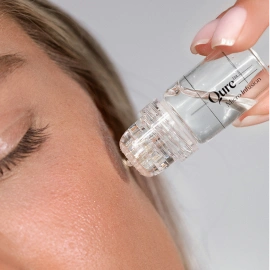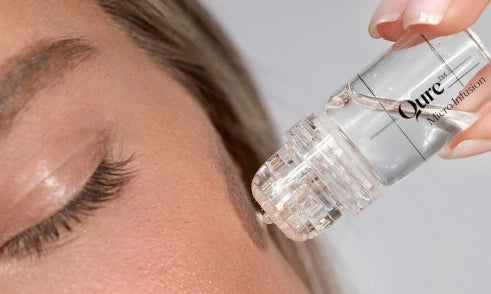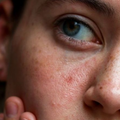Can I ice my face after microneedling? Yes—but there's a right way to do it. At Qure Skincare, we often get this question from people using our at-home Micro Infusion System, and it's an important one.
While a cool compress can help ease temporary redness or swelling, icing too soon or in the wrong way can actually disrupt your skin's natural recovery process.
That's why we've created this guide—to clear up confusion, share what works (and what doesn't), and help you get the most out of your microneedling results from home. Keep reading to learn exactly when and how to ice, along with expert-backed aftercare tips we swear by.
What this article covers:
- Can You Ice Your Face After Microneedling?
- How To Ice Your Face After Microneedling
- Microneedling Aftercare Tips
- Icing Your Face After Microneedling Vs Micro Infusion
Can You Ice Your Face After Microneedling?
Technically, yes, you can if you're really struggling with irritation or itching after microneedling. However, we usually recommend against using ice. This is because the natural inflammatory process is actually helpful for maximizing microneedling results.
But, if you have to, what matters most is timing and technique. Right after microneedling—especially an in-clinic session—your skin is extremely sensitive. Direct contact with ice can actually shock your freshly treated skin, increasing irritation rather than soothing it. Always wrap the ice in a soft cloth or opt for a chilled gel pack. Apply it gently and briefly.


Qure recommends
Discover our Best Sellers
That being said, our Qure Micro Infusion Facial System is designed with minimal to no downtime in mind. Compared to traditional in-office microneedling, our system uses shorter needles and a user-friendly design, which means less redness, less sensitivity, and less need for ice.
In fact, most of our customers find they don't need to ice at all after using our at-home system, but it's totally okay if you want to—just follow the proper steps.
When Shouldn't You Use Ice After Microneedling?
As tempting as it might be to reach for the ice tray immediately post-treatment, there are times when you shouldn't ice. After putting it to the test and diving deep into the research, we found that icing right after microneedling could potentially interfere with your skin's natural healing process.
That post-needling inflammation? It actually serves a purpose. Your body is responding to the micro-injuries by sending healing cells to the area—this process jumpstarts collagen and elastin production. Applying ice too soon may suppress this response, delaying your glow-up.
We also don't recommend icing if you've had a more aggressive treatment, have broken or bleeding skin, or if you're experiencing abnormal sensitivity. Additionally, anyone with conditions like rosacea or vascular issues should definitely check in with a professional before applying cold therapy.
How To Ice Your Face After Microneedling
Step 1: Wait At Least A Couple Of Hours
After any microneedling session, give your skin a bit of a breather. Wait two to four hours before considering any kind of cold therapy. During this time, gently cleanse your skin as recommended and avoid touching your face unnecessarily.

Step 2: Use a Barrier
Never, ever apply ice directly to your skin. Instead, wrap an ice cube or cold gel pack in a clean, soft cloth. This helps avoid cold burns and added irritation.
Step 3: Gently Press—Don't Rub
Lightly press the wrapped ice against the treated area. Think soft dabs, not harsh pressure. Keep it there for about 1-2 minutes max before removing it.
Step 4: Take Breaks
Let your skin rest between applications. You can repeat this process a couple of times during the first 24 hours if needed, but always allow your skin time to warm up in between.
Step 5: Listen To Your Skin
If it stings, burns, or feels worse—stop. In our experience, everyone's skin reacts differently, and it's okay to skip the ice altogether if it doesn't feel right.
Microneedling Aftercare Tips
Keep Hydrated
Microneedling temporarily disrupts your skin's moisture barrier. Keeping it hydrated is crucial. We always recommend using a fragrance-free, hyaluronic acid serum after microneedling or moisturizer post-treatment to lock in hydration.
Use Sunscreen
Your skin becomes more vulnerable to UV rays and sun exposure after microneedling. Starting the day after your treatment, always wear a broad-spectrum SPF 30 or higher.
Hold Off On Makeup
Let your skin breathe. Makeup can clog the freshly opened micro-channels in your skin and lead to breakouts or infection. Wait at least 24–72 hours before applying any foundation or concealer.
No Intense Workouts
Heavy sweating can introduce bacteria to your freshly treated skin and lead to irritation. Skip the gym, sauna, or hot yoga for 24–48 hours post-treatment.
Luckily, you won't have to wait as long with our Micro Infusion treatment, thanks to the minimal to no downtime it boasts. You can get back to wearing makeup and working out almost right away.

Keep It Clean
Only use clean hands, fresh pillowcases, and sanitized tools. Your skin is in a fragile state post-microneedling, and keeping it clean is your best defense against infection or unwanted breakouts. You should also use a gentle cleanser when washing face after microneedling.
Avoid Harsh Ingredients
Put your retinol, AHAs, BHAs, and vitamin C serums on hold for a little bit, and be cautious with exfoliation after microneedling. Trust us, your skin will thank you later.
Icing Your Face After Microneedling Vs Micro Infusion
Not all skin treatments are created equal—especially when it comes to how your skin reacts afterward. Here's a quick comparison of traditional microneedling versus Qure's Micro Infusion System when it comes to post-treatment sensitivity, recovery time, and the need for icing:
|
Feature |
Traditional Microneedling |
Qure Micro Infusion System |
|
Skin Trauma |
More trauma to the skin |
Gentle, controlled micro-channels |
|
Irritation Risk |
Higher risk of redness and irritation |
Lower sensitivity with proper care |
|
Recovery Time |
3–5 days of visible recovery |
Up to 24 hours of mild sensitivity |
|
Need For Icing |
Not recommended unless in extreme cases |
Rarely needed due to minimal downtime |
|
Discomfort Level |
Can feel like a sunburn |
Mild tingling or warmth |
|
Post-Treatment Restrictions |
Avoid workouts, makeup, and sunlight for several days |
Can return to most activities within 24 hours |
Choosing Micro Infusion over traditional microneedling means giving your skin the results you want—smoother texture, more even tone, and a healthy glow—without the added discomfort and extended downtime.
From our experience, it's the smarter, gentler, and more convenient option for those who want radiant skin without the hassle. Explore Qure's Micro Infusion System to upgrade your skincare routine with science-backed results that fit right into your schedule.


Learn more and share your skincare journey
Join Our VIP Community
Conclusion
Icing your face after microneedling is totally fine—as long as it's done gently, with a barrier, and at the right time. It can help soothe redness and reduce swelling, but it's not essential for everyone, especially if you're using the Qure Skincare at-home Micro Infusion System, which is designed to deliver visible results with minimal downtime.
If you're ready to elevate your skincare routine, shop the Qure Skincare Micro Infusion System and start seeing real results from the comfort of your home.
If you want to learn more, why not check out these articles below:
- Aquaphor After Microneedling
- Microneedling and Laser Together
- Microneedling in Summer
- How Long Has Microneedling Been Around?
- How Many Needles for Microneedling?
- Microneedling for PIE
- Microneedling for Pitted Scars
- Microneedling for Beard Growth
- Microneedling Recovery Time
- Nasolabial Fold Microneedling
- Shaving After Microneedling
- How to Remove Dead Skin After Microneedling
- Sauna After Microneedling
- Track Marks After Microneedling
- How Long After Microneedling Can You Get Filler?






















